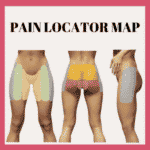
Proximal hamstring tendinopathy (PHT), sometimes called high hamstring tendinopathy, is a painful condition of the hamstring tendons. Tendons are fibrous structures that join muscles to bones. This connection allows your muscles to move your bones and body. The proximal hamstring tendons are the tendons at the top (proximal means closer to the head) of the hamstring muscles in the back of the thigh. These tendons join the hamstring muscles onto the sitting bones (ischial tuberosities).



People with PHT have pain over their hamstring tendon attachment at the sitting bone. The pain may also extend a little way down into the hamstring muscle in the back of the thigh. The pain from the tendon does not usually continue past midthigh level. Any pain extending further down the thigh or past the knee is likely to have a different cause. In these cases, there may be some associated irritation of the sciatic nerve. The sciatic nerve sits right next to the hamstring tendons as it passes through the buttock to the thigh (the yellow line on the figure adjacent to this paragraph indicates the sciatic nerve).
If the hamstring tendon is unhealthy, it can irritate the sciatic nerve as it passes by. This may result in symptoms of ‘sciatica’ (painful sciatic nerve). Pain can extend down the thigh, even all the way to the foot. Nerve irritation may result in sharp, stabbing, shooting or burning pain. There may also be feelings of tingling, buzzing, itching or numbness.
Pain from PHT is most commonly felt at the sitting bone, when:


The pain of PHT may develop over time, without a clear injury.
This can be due to:
However, for some people the pain may come on during or after a sudden hamstring strain or stretch. This might occur during waterskiing, martial arts or a slip into the splits position.
While too much load can lead to tendon conditions, too little load also reduces tendon health. Tendons that are not regularly exposed to physical load will not be as conditioned. There may reach a point where the tendon is unable to tolerate even everyday activities. Physical inactivity due to sedentary lifestyle, illness or injury elsewhere may contribute. Age and hormonal changes in women postmenopause may also reduce tendon health.
PHT is most common in middle to longer distance runners and triathletes. It may also affect cyclists who spend long periods hill climbing and on timetrial bikes. The hamstring muscles and tendons are also placed under high loads in other sports. Some examples include football, rugby, hockey, martial arts, long jump, ballet and yoga.
But you don’t need to be young and athletic to develop this condition. Older and/or sedentary people can have PHT too, due to relative underloading (not doing enough) of the tendon. Less active people will be less conditioned and less able to tolerate physical load.
Our next blog will be looking at the Treatment of Proximal Hamstring Tendinopathy – please read this to learn more about your treatment options for this condtion, and how exactly a Hip Pain Professional can help you.

Visit our Pain Locator Map to learn more about pain in different regions around the hip and pelvis.
 Want to learn more about other causes of Lower Buttock Pain?
Want to learn more about other causes of Lower Buttock Pain?When you use our Find a Hip Pain Professional Search, have a closer look at the results. Each Hip Pain Professional will specify which hip pain management they provide from the above list.
This blog was written by Dr. Alison Grimaldi, with contribution from one of our Hip Pain Professionals, Kirsty McNab, experienced physiotherapist.
Dr. Alison Grimaldi is a globally recognised expert physiotherapist, researcher, and educator, who has over 30 years professional clinical experience helping patients recover from a wide range of hip and pelvic conditions.

Dr. Alison Grimaldi BPhty, MPhty(Sports), PhD, FACP
Dr Grimaldi has completed Bachelor of Physiotherapy, Master of Physiotherapy and Doctor of Philosophy (Physiotherapy) degrees. She is a fellow of the Australian College of Physiotherapists, Practice Principal of PhysioTec Physiotherapy, an Australian Sports Physiotherapist , an Adjunct Senior Research Fellow at the University of Queensland, as well as an author and global educator. Her passion is helping people with hip pain, and educating other health professionals around how to help more people with hip pain.

